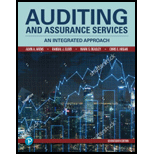
EBK AUDITING+ASSURANCE SERVICES
17th Edition
ISBN: 9780135171219
Author: ARENS
Publisher: PEARSON CO
expand_more
expand_more
format_list_bulleted
Question
Chapter 17, Problem 23.2MCQ
To determine
Identify effect of variable sampling.
Expert Solution & Answer
Want to see the full answer?
Check out a sample textbook solution
Students have asked these similar questions
What would be the cost of the land be recorded as?
MCQ
Solve with explanation and accounting question
Chapter 17 Solutions
EBK AUDITING+ASSURANCE SERVICES
Ch. 17 - Prob. 1RQCh. 17 - Prob. 2RQCh. 17 - Prob. 3RQCh. 17 - Prob. 4RQCh. 17 - Prob. 5RQCh. 17 - Prob. 6RQCh. 17 - Prob. 7RQCh. 17 - Prob. 8RQCh. 17 - Prob. 9RQCh. 17 - Prob. 10RQ
Ch. 17 - Prob. 11RQCh. 17 - Prob. 12RQCh. 17 - Prob. 13RQCh. 17 - Prob. 14RQCh. 17 - Prob. 15RQCh. 17 - Prob. 16RQCh. 17 - Prob. 17RQCh. 17 - Prob. 18RQCh. 17 - Prob. 19RQCh. 17 - Prob. 20RQCh. 17 - Prob. 21.1MCQCh. 17 - Prob. 21.2MCQCh. 17 - Prob. 21.3MCQCh. 17 - Prob. 22.1MCQCh. 17 - Prob. 22.2MCQCh. 17 - Prob. 22.3MCQCh. 17 - Prob. 23.1MCQCh. 17 - Prob. 23.2MCQCh. 17 - Prob. 23.3MCQCh. 17 - Prob. 24.1MCQCh. 17 - Prob. 24.2MCQCh. 17 - Prob. 24.3MCQCh. 17 - Prob. 25DQPCh. 17 - Prob. 26DQPCh. 17 - Prob. 27DQPCh. 17 - Prob. 28DQPCh. 17 - Prob. 29DQPCh. 17 - Prob. 30DQPCh. 17 - Prob. 31DQPCh. 17 - Prob. 32DQPCh. 17 - Prob. 34DQPCh. 17 - Prob. 35DQP
Knowledge Booster
Similar questions
- I need help with this General accounting question using the proper accounting approach.arrow_forwardPlease help me solve this general accounting problem with the correct financial process.arrow_forwardPlease provide the solution to this general accounting question using proper accounting principles.arrow_forward
- Using the High-Low method, calculate the total fixed costs and variable cost per unit based on the following production data: Months Total Cost ($) Units Produced June 390,000 12,000 July 570,000 22,000 August 480,000 18,000 September 630,000 26,000 October 450,000 16,000 What are the total fixed costs? a. $150,000 b. $210,000 c. $180,000 d. None of the abovearrow_forwardPlease provide the correct answer to this general accounting problem using accurate calculations.arrow_forwardPlease provide the accurate answer to this general accounting problem using valid techniques.arrow_forward
- I am looking for a step-by-step explanation of this financial accounting problem with correct standards.arrow_forwardI need help with this General accounting question using the proper accounting approach.arrow_forwardPlease provide the correct answer to this general accounting problem using accurate calculations.arrow_forward
arrow_back_ios
SEE MORE QUESTIONS
arrow_forward_ios
Recommended textbooks for you
 Auditing: A Risk Based-Approach (MindTap Course L...AccountingISBN:9781337619455Author:Karla M Johnstone, Audrey A. Gramling, Larry E. RittenbergPublisher:Cengage Learning
Auditing: A Risk Based-Approach (MindTap Course L...AccountingISBN:9781337619455Author:Karla M Johnstone, Audrey A. Gramling, Larry E. RittenbergPublisher:Cengage Learning Auditing: A Risk Based-Approach to Conducting a Q...AccountingISBN:9781305080577Author:Karla M Johnstone, Audrey A. Gramling, Larry E. RittenbergPublisher:South-Western College Pub
Auditing: A Risk Based-Approach to Conducting a Q...AccountingISBN:9781305080577Author:Karla M Johnstone, Audrey A. Gramling, Larry E. RittenbergPublisher:South-Western College Pub

Auditing: A Risk Based-Approach (MindTap Course L...
Accounting
ISBN:9781337619455
Author:Karla M Johnstone, Audrey A. Gramling, Larry E. Rittenberg
Publisher:Cengage Learning

Auditing: A Risk Based-Approach to Conducting a Q...
Accounting
ISBN:9781305080577
Author:Karla M Johnstone, Audrey A. Gramling, Larry E. Rittenberg
Publisher:South-Western College Pub